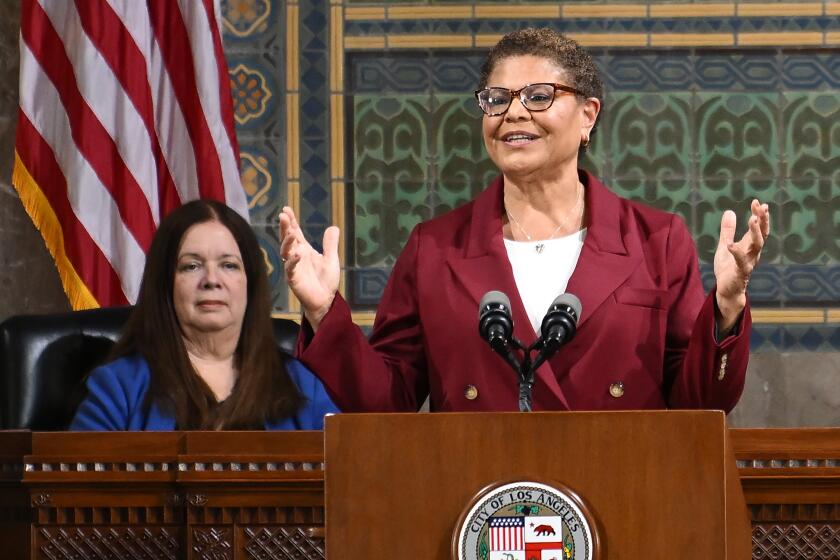Grand Ave. -- a bad deal for Joe Taxpayer
- Share via
DEVELOPERS OF the Grand Avenue project in Los Angeles’ civic center are attempting to build a $2-billion hotel-retail-condo complex — not on their own dime but on yours. It is the taxpayers of Los Angeles County who would subsidize downtown luxury hotel guests at $400-plus a night.
Not long ago, we were promised that this project would be built without taxpayer subsidies. Now, in addition to a deal on the city and county land the project will be built on, the developer wants tax breaks that could reach $66 million over 20 years for the first phase of construction. The developer, the Related Cos. of New York, also admits that it is likely to come back for more subsidies for the second and third phases. That’s in addition to $30 million in “public assistance” from the Community Redevelopment Agency and the county — for a total public “down payment” of nearly $100 million.
Two years ago, the county retained economist Allan Kotin, who stated that the project “is definitely not a revenue-maximizing plan for the landowner [the taxpayers].” Given the state of the real estate market today, with decreased demand and increased construction costs, that statement resonates even louder. If the project were a good investment, it would attract more private capital and no subsidy would be required.
Proponents of Grand Avenue — which would cover 16 acres extending south from Grand Avenue along First Street and include a $185-million hotel, 449,000 square feet of retail, up to 681,000 square feet of office space and about 2.5 million square feet of high-rise residential units along with an improved civic center park — contend that the project would be the new economic engine for downtown L.A. They also point out again and again that 20% of the housing created would be “low-income” units.
But these “pluses” need careful examination. First, consider housing. To be economically feasible, affordable housing in Southern California is typically low-rise. The high-rise towers planned for Grand Avenue are far and away the most expensive type of housing construction. If the social goal is to provide affordable housing, we can invest our public money in a more cost-effective manner.
Another supposed benefit of the Grand Avenue project — an improved civic park running from the Music Center to City Hall — would be paid for out of $50 million worth of deferred rental fees on the public land beneath the commercial Grand Avenue buildings. It is yet to be determined, however, whether the buildings on either side of this park area — the county’s Hall of Administration and the Stanley Mosk Courthouse — would be demolished, replaced or relocated. It is imprudent to commit millions in public money to improve a park without having any idea what type of buildings would surround it.
Then there is the matter of whether Grand Avenue would be the economic engine we’ve been promised. We’ve heard these same arguments during the debate about the L.A. Live project adjacent to the downtown Staples Center, which also includes ground-floor retail, luxury condos and high-end hotel rooms — and massive subsidies. One can only speculate as to whether both of these projects will create and sustain the demand necessary to survive economically.
It’s crucial that the residents of L.A. County understand that Grand Avenue comes with trade-offs. If tomorrow we sold just the county land underlying the development, conservative estimates indicate that it would bring in nearly $100 million. That means we could spend $50 million to improve the civic center park and have nearly $50 million to pay for much more, and much more cost-effective, low-income housing.
On top of that, consider what our subsidies could pay for, if they didn’t go toward paying for the Grand Avenue development. Nearly $5 million of the “public assistance” for the Grand Avenue project would come from unrestricted county taxpayer funds that could be used instead for public safety, public education, parks, libraries or relief of regional traffic congestion.
I believe that development of county- and city-owned property should be a taxpayer-driven process rather than developer-driven, and that the majority of the benefits from that process should accrue to residents, not to the out-of-state developer. Although some of the goals of the Grand Avenue project are laudable, there remain more questions than answers.
The project is scheduled to be voted on today, after just one day of debate, by the Board of Supervisors and the Los Angeles City Council. Several public meetings to discuss the development have been canceled. This isn’t right. The economic analysis of this project should be disseminated to all residents in the city and in the other 87 cities and 134 unincorporated communities of the county. A reasonable amount of time should be set aside for a thorough debate and analysis on the real merits of the Grand Avenue project.
More to Read
Sign up for Essential California
The most important California stories and recommendations in your inbox every morning.
You may occasionally receive promotional content from the Los Angeles Times.













![Vista, California-Apri 2, 2025-Hours after undergoing dental surgery a 9-year-old girl was found unresponsive in her home, officials are investigating what caused her death. On March 18, Silvanna Moreno was placed under anesthesia for a dental surgery at Dreamtime Dentistry, a dental facility that "strive[s] to be the premier office for sedation dentistry in Vitsa, CA. (Google Maps)](https://ca-times.brightspotcdn.com/dims4/default/07a58b2/2147483647/strip/true/crop/2016x1344+29+0/resize/840x560!/quality/75/?url=https%3A%2F%2Fcalifornia-times-brightspot.s3.amazonaws.com%2F78%2Ffd%2F9bbf9b62489fa209f9c67df2e472%2Fla-me-dreamtime-dentist-01.jpg)